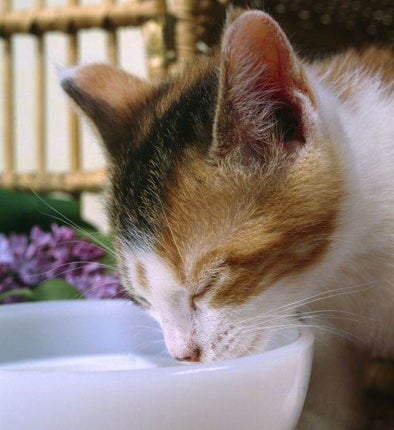Why the cat that gets the cream is smarter than we thought it was

A cat's tongue performs the equivalent of complex mathematical calculations to keep two opposing forces in perfect equilibrium when it laps up milk from a bowl, a study has found.
Scientists have discovered the precise physical mechanism that enables cats to lap up liquids without getting their chins wet. Until now it was thought that the animals curled their tongues backwards to create a "J" shaped curve that acts like a kind of reverse-facing ladle for the milk, but the latest study shows this is a fallacy.
Instead, only the tip of the upper surface of the tongue is brought into direct contact with the milk. As the cat rapidly retracts its tongue, a column of milk rises towards its mouth until the inertia of the column is exactly balanced by the force of gravity, which is pulling it back towards the bowl. At this point, the cat closes its mouth over the column of milk, which is floating in mid-air, and takes its drink.
"The amount of liquid available for the cat to capture each time it closes its mouth depends on the size and speed of the tongue," said Jeffrey Aristoff of Princeton University, who analysed the action of cats' tongues for a study published in the journal Science.
"Our research – the experimental measurements and theoretical predictions – suggests that the cat chooses the speed to maximise the amount of liquid ingested per lap. This suggests that cats are smarter than many people think, at least when it comes to hydrodynamics," he added.
High-speed digital video shows that when a domestic cat is drinking, its tongue moves at a speed of about one metre a second and it laps about four times a second, each lap bringing about 0.1 millilitres of liquid into the mouth. Bigger cats, such as lions and tigers, lap at a slower speed to maintain the balance between gravity and inertia, the scientists said.
Sunghwan Jung of Virginia Tech said: "At the beginning of the project we weren't fully confident that fluid mechanics played a role in cats' drinking. But as the project went on, we were surprised and amused by the beauty of the fluid mechanics involved in this system."
The research was carried out with the help of Cutta Cutta, a pet cat owned by Roman Stocker of the Massachusetts Institute of Technology, who led the study.
Join our commenting forum
Join thought-provoking conversations, follow other Independent readers and see their replies
Comments
Bookmark popover
Removed from bookmarks